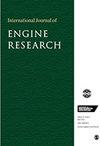用于排放控制的静电电池(ESBEC):进一步开发和测试柴油机排放
IF 2.1
4区 工程技术
Q2 ENGINEERING, MECHANICAL
引用次数: 0
摘要
我们最近开发了一种新型柴油机排放控制装置--排放控制静电屏电池(ESBEC),通过静电机制将柴油机废气颗粒清除到金属网上。在这项研究中,我们对最初的 ESBEC 设计进行了以下改进:(1) 使用不同孔隙率的金属收集滤网,使捕获的柴油废气更均匀地分布在整个 ESBEC 中;(2) 重新设计滤网支架,便于 ESBEC 的组装;(3) 使用耐热材料制造当前的模型,直径为 3 英寸,长度为 4 英寸。在实验室中对 ESBEC 进行了研究,以优化筛网的孔隙率和配置。然后,在现场用柴油发电机排出的柴油微粒物质(DPM)对其进行挑战。发电机产生的 DPM 质量浓度从 38 mg/m3 到 187 mg/m3 不等,通过 ESBEC 的空气流速从 219 L/min 到 410 L/min 不等。此外,我们还将 ESBEC 的颗粒收集效率与传统的柴油微粒过滤器 (DPF) 进行了比较。我们还探索了各种清洗方法,以有效去除 ESBEC 捕获的 DPM。当受到 DPM 的挑战时,ESBEC 在 26 小时内的收集效率为 100%,在此期间捕获了 60 克 DPM。相比之下,DPF 的收集效率为 77%。在总运行时间达到 46 小时后,ESBEC 的收集效率下降到 CARB(加利福尼亚空气资源委员会)3 级(85%),累积了 102 克 DPM。ESBEC 运行超过 46 小时后,其收集效率仍为 85%。不过,在异丙醇中清洗滤网 5 分钟后,收集效率恢复到 86%。今后的研究将考察 ESBEC 安装在实际柴油动力汽车中的性能。本文章由计算机程序翻译,如有差异,请以英文原文为准。
Electrostatic battery for emissions control (ESBEC): Further development and testing with diesel emissions
We recently developed a novel diesel emissions control device, Electrostatic Screen Battery for Emissions Control (ESBEC), where an electrostatic mechanism removes diesel exhaust particles onto metal screens. In this study, we made the following improvements to the initial ESBEC’s design: (1) used metal collection screens of different porosity for a more even distribution of captured diesel exhaust throughout ESBEC, (2) redesigned screen holders for easy assembly of ESBEC, (3) heat-resistant materials were used to build the current model, which is 3 in. in diameter and 4 in. in length. ESBEC was investigated in a laboratory to optimize the screen porosity and configuration. Then, in the field, it was challenged with diesel particulate matter (DPM) exhausted from a diesel electric power generator. The DPM mass concentrations produced by the generator varied from 38 to 187 mg/m3 , and air flow rates passing through ESBEC varied from 219 to 410 L/min. The testing was intermittently performed over 49 h. In addition, ESBEC’s particle collection efficiency was compared to that of a traditional diesel particulate filter (DPF). We also explored various washing methods to effectively remove DPM captured by ESBEC. When challenged with DPM, ESBEC showed collection efficiency of ∼100% for 26 h, during which 60 g of DPM was captured. For comparison, the collection efficiency of DPF was ∼77%. After the total run time of 46 h, the collection efficiency of ESBEC decreased to CARB (California Air Resources Board) Level 3 (85%), with 102 g DPM accumulated. When ESBEC was operated beyond 46 h, its collection efficiency was <85%. However, washing screens for 5 min in isopropyl alcohol restored the collection efficiency to 86%. Future studies will examine the performance of ESBEC when it is installed in an actual diesel-powered vehicle.
求助全文
通过发布文献求助,成功后即可免费获取论文全文。
去求助
来源期刊

International Journal of Engine Research
工程技术-工程:机械
CiteScore
6.50
自引率
16.00%
发文量
130
审稿时长
>12 weeks
期刊介绍:
The International Journal of Engine Research publishes high quality papers on experimental and analytical studies of engine technology.
 求助内容:
求助内容: 应助结果提醒方式:
应助结果提醒方式:


